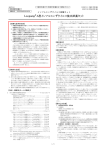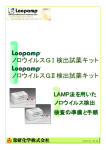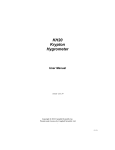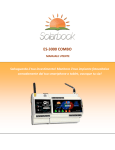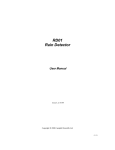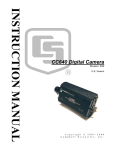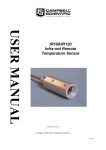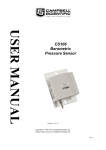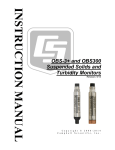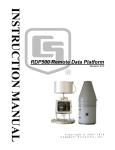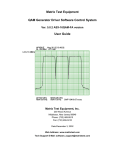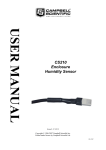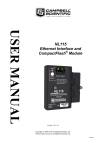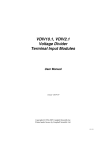Download CS10 and CS15 Current Transformers
Transcript
CS10 and CS15 Current Transformers User Manual Issued: 16.4.12 Copyright © 2001-2012 Campbell Scientific Inc. Printed under Licence by Campbell Scientific Ltd. CSL 852 Guarantee This equipment is guaranteed against defects in materials and workmanship. This guarantee applies for twelve months from date of delivery. We will repair or replace products which prove to be defective during the guarantee period provided they are returned to us prepaid. The guarantee will not apply to: • Equipment which has been modified or altered in any way without the written permission of Campbell Scientific • Batteries • Any product which has been subjected to misuse, neglect, acts of God or damage in transit. Campbell Scientific will return guaranteed equipment by surface carrier prepaid. Campbell Scientific will not reimburse the claimant for costs incurred in removing and/or reinstalling equipment. This guarantee and the Company’s obligation thereunder is in lieu of all other guarantees, expressed or implied, including those of suitability and fitness for a particular purpose. Campbell Scientific is not liable for consequential damage. Please inform us before returning equipment and obtain a Repair Reference Number whether the repair is under guarantee or not. Please state the faults as clearly as possible, and if the product is out of the guarantee period it should be accompanied by a purchase order. Quotations for repairs can be given on request. It is the policy of Campbell Scientific to protect the health of its employees and provide a safe working environment, in support of this policy a “Declaration of Hazardous Material and Decontamination” form will be issued for completion. When returning equipment, the Repair Reference Number must be clearly marked on the outside of the package. Complete the “Declaration of Hazardous Material and Decontamination” form and ensure a completed copy is returned with your goods. Please note your Repair may not be processed if you do not include a copy of this form and Campbell Scientific Ltd reserves the right to return goods at the customers’ expense. Note that goods sent air freight are subject to Customs clearance fees which Campbell Scientific will charge to customers. In many cases, these charges are greater than the cost of the repair. Campbell Scientific Ltd, Campbell Park, 80 Hathern Road, Shepshed, Loughborough, LE12 9GX, UK Tel: +44 (0) 1509 601141 Fax: +44 (0) 1509 601091 Email: [email protected] www.campbellsci.co.uk PLEASE READ FIRST About this manual Please note that this manual was originally produced by Campbell Scientific Inc. primarily for the North American market. Some spellings, weights and measures may reflect this origin. Some useful conversion factors: Area: 1 in2 (square inch) = 645 mm2 Length: 1 in. (inch) = 25.4 mm 1 ft (foot) = 304.8 mm 1 yard = 0.914 m 1 mile = 1.609 km Mass: 1 oz. (ounce) = 28.35 g 1 lb (pound weight) = 0.454 kg Pressure: 1 psi (lb/in2) = 68.95 mb Volume: 1 UK pint = 568.3 ml 1 UK gallon = 4.546 litres 1 US gallon = 3.785 litres In addition, while most of the information in the manual is correct for all countries, certain information is specific to the North American market and so may not be applicable to European users. Differences include the U.S standard external power supply details where some information (for example the AC transformer input voltage) will not be applicable for British/European use. Please note, however, that when a power supply adapter is ordered it will be suitable for use in your country. Reference to some radio transmitters, digital cell phones and aerials may also not be applicable according to your locality. Some brackets, shields and enclosure options, including wiring, are not sold as standard items in the European market; in some cases alternatives are offered. Details of the alternatives will be covered in separate manuals. Part numbers prefixed with a “#” symbol are special order parts for use with non-EU variants or for special installations. Please quote the full part number with the # when ordering. Recycling information At the end of this product’s life it should not be put in commercial or domestic refuse but sent for recycling. Any batteries contained within the product or used during the products life should be removed from the product and also be sent to an appropriate recycling facility. Campbell Scientific Ltd can advise on the recycling of the equipment and in some cases arrange collection and the correct disposal of it, although charges may apply for some items or territories. For further advice or support, please contact Campbell Scientific Ltd, or your local agent. Campbell Scientific Ltd, Campbell Park, 80 Hathern Road, Shepshed, Loughborough, LE12 9GX, UK Tel: +44 (0) 1509 601141 Fax: +44 (0) 1509 601091 Email: [email protected] www.campbellsci.co.uk Contents PDF viewers note: These page numbers refer to the printed version of this document. Use the Adobe Acrobat® bookmarks tab for links to specific sections. 1. General Description .................................................... 1 2. Specifications .............................................................. 1 3. Installation.................................................................... 2 4. Wiring ........................................................................... 3 5. Programming ............................................................... 3 5.1 5.2 5.3 5.4 5.5 5.6 CR800, CR850, CR1000, or CR3000 Programming ................................ 3 CR200(X)-series Dataloggers ................................................................... 4 CR510, CR10X, CR23X Dataloggers ...................................................... 6 21X, CR7 Dataloggers .............................................................................. 8 CR1000 with Multiplexer Sample Program ........................................... 10 CR10X with Multiplexer Sample Program............................................. 11 Appendix A. Theory of Operation ................................................ A-1 A.1 A.2 A.3 A.4 A.5 Typical Electrical Circuit .................................................................... A-1 Current Transformer Description........................................................ A-3 Converting a Milliamp Signal to a Millivolt Signal............................ A-4 Multiplier ............................................................................................ A-5 CS10/CS15 Comparison ..................................................................... A-5 Figures 1. CS10 Current Transformer ......................................................................... 1 2. AC Load Wire Installed in CS10 (colour of ac load wire can vary)........... 2 3. Graph of a CS15 Waveform ....................................................................... 5 4. Graph of CS10 Waveform using Burst Mode ............................................ 7 5. Graph of a CS10 Waveform using 90 Samples of Amperage .................... 8 A-1. Generator Schematic ......................................................................... A-1 A-2. Schematic of Generator with Current Transformer ........................... A-2 A-3. Schematic of Current Transformer with the Wire ............................. A-2 A-4. CS10 with the Wire ........................................................................... A-3 A-5. Magnetic Flux Schematic .................................................................. A-3 A-6. Windings Schematic .......................................................................... A-4 A-7. CS10 Schematic................................................................................. A-5 A-8. Adding 1250 mV Creates Positive Output ........................................ A-6 A-9. CS15 Schematic................................................................................. A-6 A-10. CS15 Measurement Range .............................................................. A-7 i CS10 and CS15 Current Transformers 1. General Description Campbell Scientific’s CS10 and CS15 detect and measure the ac current along an electrical wire using the magnetic field that is generated by that current. The CS10 or the CS15 do not have direct electrical connection to the system. These sensors output a millivolt signal allowing them to be directly connected to our dataloggers. The CS10 is compatible with our CR800, CR850, CR1000, CR3000, CR510, CR10(X), and CR23X dataloggers. It uses CR Magnetic’s CR8459 Current Transducer to measure the approximate current over a range of 0 to 200 A. The CS15 was developed specifically for our CR200(X)-series dataloggers. It is a modified version of the CS10 that measures the approximate current over the range of 0 to 125 A. Both sensors are recommended for measurements that do not require high accuracy. Figure 1. CS10 Current Transformer 2. Specifications Example Applications: • • • • Motor or generator load conditions Efficiency studies Intermittent fault detection Rough submetering 1 CS10 and CS15 Current Transformers Specifications Measurement Ranges: Frequency: Insulation Resistance: High Potential: Rated Current: Storage Temperature: Operating Temperature: Case Material: Construction: Accuracy with 10 ohm burden max. (resistive): Dimensions: 0.15 to 200 A (CS10) 0.15 to 125 A (CS15) 50 and 60 Hz 100 M ohm @ 500 VDC 2000 volts 200 A (CS10), 125 A (CS15) -25ºC to 70ºC -25ºC to 55ºC Polypropylene Resin Epoxy Encapsulated typically ±5 percent of actual value with provided multiplier Outer diameter: 4.8 cm (1.89”) Inner diameter: 1.9 cm (0.75”) Height: 1.7 cm (0.67”) 3. Installation Place one AC load wire through the hole of the CS10 or CS15 (see Figure 2). Figure 2. AC Load Wire Installed in CS10 (colour of ac load wire can vary) 2 User Manual 4. Wiring The CS10 and CS15 use a single-ended analogue channel as follows. CS10 CS15 White Single-Ended Channel Red EX Black AG or White SE Shield AG or Black Shield 5. Programming NOTE SCWIN users: This manual was written primarily for those whose needs are not met by SCWin. Your procedure is much simpler: just add the CS10 or CS15 (in the Miscellaneous Sensors folder), save your program, and follow the wiring shown in Step 2 of SCWin. The datalogger is programmed using either CRBasic or Edlog. Dataloggers that use CRBasic include our CR200(X)-series, CR800, CR850, CR1000, and CR3000. Dataloggers that use Edlog include our CR510, CR10(X), and CR23X. In CRBasic, the VoltSE instruction is used to measure the sensor. In Edlog, a P1 instruction is used. In order to monitor the amperage of an alternating current circuit, the program must take many samples from the CS10 or CS15 sensor to capture the waveform over a specified time, and then calculate the average energy under the curve. There are many methods to do this, depending on the datalogger, the untapped programming capacity, and other factors. 5.1 CR800, CR850, CR1000, or CR3000 Programming With these dataloggers, the best method for monitoring amperage is to make millivolt burst measurements, and then calculate RMS. The millivolt burst measurements are made by using the VoltSE instruction with multiple reps on the same channel (i.e., negative value for channel number). The SpaDevSpa instruction calculates RMS. NOTE Program must be run in the pipeline mode. It is important to get complete cycles. If you make 100 measurements during a 0.1 second time period, you’ll get five complete cycles for a 50 Hz waveform or six complete cycles for a 60 Hz waveform. CAUTION Do not average the waveform or use 60 Hz (or 50 Hz) rejection. Under these circumstances, the amperage value will always be zero. 3 CS10 and CS15 Current Transformers Below is an example CR1000 program. In the program, a multiplier of 0.2 is applied to the RMS value; see Section A.4 for more information. 'CR1000 program to measure rms current PipeLineMode 'must be pipeline mode Const num_samples = 100 Public Amps Public Amp_mult Dim i_sig (num_samples) PreserveVariables '100 Samples @ 1000 micro sec = 0.1 second (5 @ 50Hz or 6 @ 60 Hz). 'the line current 'to hold the burst measurements, each 100 samples long 'to store values between power cycles DataTable (AmpTable,True,-1) DataInterval (0,1,Min,10) Maximum (1,Amps,IEEE4,False,False) Average (1,Amps,FP2,False) EndTable BeginProg Amp_mult = 0.2 '0.2 multiplier for the CS10 Scan (250, mSec, 10, 0) VoltSe (i_sig (1), num_samples, mV2500,-1, True, 1000, 0, 1.0, 0) StdDevSpa (Amps, num_samples, i_sig (1)) Amps = Amps * Amp_mult 'put in amps CallTable (AmpTable) NextScan EndProg 5.2 CR200(X)-series Dataloggers The CS15 is manufactured specifically for the CR200(X)-series dataloggers. It has an extra wire and requires an ExciteV instruction in the program. The voltage excitation creates a positive reference output that the CR200(X)-series can measure. The recommended programming method for CR200(X)-series dataloggers (where the scan interval is limited to once per second) is to place the VoltSE instruction within a loop. The first CR200(X) example program has a loop that samples 25 times, and the second CR200(X) example program has a loop that samples 30 times. A 25-sample loop produces almost two cycles of a 60 Hz wave form, and a 30-sample loop produces almost two cycles of a 50 Hz wave form (see Figure 3). The average energy under the curve is calculated using the RMSSpa instruction. A multiplier of 0.2 is applied to the RMS value; see Section A.4 for more information. 4 User Manual 25 Samples of Amperage on CR200(X) Datalogger (60 Hz) or 30 Samples of Amperage on CR200(X) Datalogger (50 Hz) 80 60 40 mV 20 0 -20 CS15 waveform CS15-L waveform 1 3 5 7 9 11 13 15 17 19 21 23 25 -40 -60 -80 InstanteneousAmps Amps Instantaneous Figure 3. Graph of a CS15 Waveform CR200(X) Program for 60 Hz 'CR200(X) Series Datalogger ' Program name: CS15 Manual.cr2 'date: 4 Mar 2009 'program author: Brad Maxfield Const Samples = 25 'Const Samples = 30 Public Crnt_A Public mV(Samples) Dim Counter ' 25 samples for 2 waves of 60 Hz. ' 30 samples for 2 waves of 50 Hz. 'Define Data Tables DataTable (Test,1,-1) DataInterval (0,1,min) Average (1,Crnt_A,False) Maximum (1,Crnt_A,False,0) EndTable 'Main Program BeginProg Scan (1,Sec) ExciteV (Ex1,mV2500) For Counter = 1 To Samples VoltSe (mV(Counter),1,1,1.0,-1250) Next ExciteV (Ex1,mV0) RMSSpa (Crnt_A,(Samples-0),mV(1)) Crnt_A=Crnt_A*0.2 ' Multiplier for sensor If Crnt_A<0.15 Then ' Eliminate noise below 0.15 amps. Crnt_A = 0 EndIf 5 CS10 and CS15 Current Transformers CallTable Test NextScan EndProg CR200(X) Program for 50 Hz ' CR200(X) Series Datalogger ' Program name: CS15Manual.cr2 ' date: 4 Mar 2009 ' program author: Brad Maxfield Const Samples = 30 'Const Samples = 25 Public Crnt_A Public mV(Samples) Dim Counter ' 30 samples for 2 waves of 50 Hz. ' 25 samples for 2 waves of 60 Hz. 'Define Data Tables DataTable (Test,1,-1) DataInterval (0,1,min) Average (1,Crnt_A,False) Maximum (1,Crnt_A,False,0) EndTable 'Main Program BeginProg Scan (1,Sec) ExciteV (Ex1,mV2500) For Counter = 1 To Samples VoltSe (mV(Counter),1,1,1.0,-1250) Next ExciteV (Ex1,mV0) RMSSpa (Crnt_A,(Samples-0),mV(1)) Crnt_A=Crnt_A*0.2 ' Multiplier for sensor If Crnt_A<0.15 Then ' Eliminate noise below 0.15 amps. Crnt_A = 0 EndIf CallTable Test NextScan EndProg 5.3 CR510, CR10X, CR23X Dataloggers With these dataloggers, the best method for monitoring amperage is to make millivolt burst measurements using Instruction 23 and then calculate RMS using Instruction 82. For Instruction 23, the entry for parameter 4 needs to be 0001. This triggers on the first channel, triggers immediately, stores data in input locations, and makes single-ended measurements. 6 User Manual Remember that it is important to get complete cycles. For Instruction 23, if parameters 5 and 6 are 2.0 and 0.05, respectively, then you get five complete cycles for a 50-Hz waveform, and six complete cycles for a 60-Hz waveform (see Figure 4). The multiplier for the CS10 is 0.2; see Section A.4 for more information. Six Cycles at 60 Hz Burst CR10X I Instanteneous Figure 4. Graph of CS10 Waveform using Burst Mode The following CR10X program generates the waveforms shown in Figure 4. NOTE The instructions listed below do not store data in final storage. P92, P77, and output processing instructions such as P70 are required to store the data permanently. ; Parameter 2 should be 2500 mV for 50-200 amps ; should be 250 mV for 5-49 amps ; should be 25 mV for 0-4.9 amps ; Parameter 5 should be 2.0 msec for 50 Hz or 60 Hz ; Parameter 6 should be 0.05 thousand scans for 50 Hz or 60 Hz ; if parameter 5 & 6 are 2.0 and 0.05, then you have 5 complete cycles at 50 Hz ; or 6 complete cycles at 60 Hz. ; 1: Burst Measurement (P23) 1: 1 Input Channels per Scan ; Should always be 1 2: 15 2500 mV Fast Range ; Change according to expected Amperage 3: 1 In Chan ; Change according to Wiring 4: 0001 Trig/Trig/Dest/Meas Options ; Should always be 0001 5: 2.0 Time per Scan (msec) ; Must be 2.0 6: .05 Scans (in thousands) ; Must be 0.05 (for 50 measurements * 2.0 msec = 100 mS) 7: 0 Samples before Trigger ; Should always be 0 8: 0.0 mV Limit ; Should always be 0 9: 0000 mV Excitation ; Should always be 0 10: 4 Loc [ Amps_1 ] ; First location of Block (array) 11: .2 Multiplier ; Match Multiplier of CT:0.2 for CS10 with 10 ohm shunt 12: 0.0 Offset 2: Z=F x 10^n (P30) 1: 0.0 F 2: 00 n, Exponent of 10 3: 1 Z Loc [ Counter ] 7 CS10 and CS15 Current Transformers ; This part of the program will calculate the RMS Amperage ; Standard Deviation in this part of the code works mathematically the same ; as RMS calculation, and it is easier to program this way. The RMS ; value is calculated and stored back into an input location for further ; processing if needed. 3: Beginning of Loop (P87) 1: 0 Delay 2: 50 Loop Count 4: Z=Z+1 (P32) 1: 1 Z Loc [ Counter ] 5: If (X<=>F) (P89) 1: 1 X Loc [ Counter ] 2: 1 = 3: 50 F 4: 10 Set Output Flag High (Flag 0) 6: Set Active Storage Area (P80) 1: 3 Input Storage Area 2: 2 Loc [ BurstAmps ] 7: Standard Deviation (P82)^3012 1: 1 Reps 2: 4 -- Sample Loc [ Amps_1 ] 8: End (P95) 5.4 21X, CR7 Dataloggers Some Edlog dataloggers such as the 21X and CR7 do not have a burst mode. For those dataloggers, you can use a “Loop Measurement Method” similar to the method used with the CR200(X). This method is also an option for our CR510, CR10X, and CR23X, but only three measurements per period will be made. Figure 5 shows a graph produced by a CR10X program with a loop that samples 90 times. A portion of this program is shown below. 32 cycles 60 Hz 90 samples in loop on CR10X I instanteneous Figure 5. Graph of a CS10 Waveform using 90 Samples of Amperage 8 User Manual NOTE The instructions listed below do not store data in final storage. P92, P77, and output processing instructions such as P70 are required to store the data permanently. 3: Beginning of Loop (P87) 1: 0 Delay 2: 90 Loop Count 4: Z=Z+1 (P32) 1: 4 Z Loc [ Counter ] 5: Volt (SE) (P1) 1: 1 2: 14 3: 1 4: 57 -5: .2 6: 0.0 Reps 250 mV Fast Range SE Channel Loc [ LoopAmp_1 ] Multiplier Offset 6: If (X<=>F) (P89) 1: 4 X Loc [ Counter ] 2: 1 = 3: 90 F 4: 10 Set Output Flag High (Flag 0) 7: Z=X (P31) 1: 57 -- X Loc [ LoopAmp_1 ] 2: 3 Z Loc [ Sensor ] 8: Set Active Storage Area (P80) 1: 3 Input Storage Area 2: 2 Loc [ Amp ] 9: Standard Deviation (P82)^12989 1: 1 Reps 2: 3 Sample Loc [ Sensor ] 10: End (P95) The above CR10X program may provide an adequate waveform because the program makes more than two measurements per period and samples many periods. However, if the datalogger’s Burst Measurement Instruction is used with specific settings, the program will make more measurements per cycle assuring that complete periods for both 50 and 60 Hz (5 at 50 Hz and 6 at 60 Hz) will be monitored (see Figure 4). 9 CS10 and CS15 Current Transformers 5.5 CR1000 with Multiplexer Sample Program This program uses the CR1000 and an AM16/32-series multiplexer to read 32 CS10 current transformers. 'CR1000 program to measure rms current PipeLineMode Const num_samples = 100 Const NumSensors=32 Public Amps(NumSensors), i, Batt_Volt Public Amp_mult, TempAmps Dim i_sig (num_samples) PreserveVariables 'must be pipeline mode '6 waveforms for 60 Hz, 5 waveforms for 50 Hz 'Number of Sensors on the Mux MUX in 2X32 Mode ***** 'Sensor wired to Low on each of the 32 channels. 'Odd Low on Mux wired to SE2 on Datalogger 'the line current 'to hold the burst measurements, each 100 samples long 'to store values between power cycles DataTable (AmpTable,True,-1) DataInterval (0,1,Min,10) Maximum (NumSensors,Amps,IEEE4,False,False) Average (NumSensors,Amps,FP2,False) EndTable BeginProg Amp_mult = 0.2 '0.2 multiplier for the CS10/CS15 Scan (10,Sec,0,0) Battery (Batt_volt) 'Turn AM16/32 Multiplexer On PortSet(4,1) i=0 SubScan(0,uSec,NumSensors) 'Switch to next AM16/32 Multiplexer Channel PulsePort(5,10000) i=i+1 VoltSe (i_sig (1), num_samples, mV2500,-2, True, 1000, 0, 1.0, 0) StdDevSpa (Amps(i), num_samples, i_sig (1)) Amps(i) = Amps(i) * Amp_mult 'put in amps If Amps(i) <= 0.15 Then Amps(i) = 0 NextSubScan 'Turn AM16/32 Multiplexer Off PortSet(4,0) CallTable (AmpTable) NextScan EndProg 10 User Manual 5.6 CR10X with Multiplexer Sample Program This program uses the CR10X and an AM16/32-series multiplexer to read 32 CS10 current transformers. ;{CR10X} ; Example program for CS10-L ; ; Program to test the CS10-L or CS15-L sensor on a CR10X datalogger ; and AM1632 Multiplexer. ; *Table 1 Program 01: 30 Execution Interval (seconds) ; Turn on the multiplexer 1: Do (P86) 1: 41 Set Port 1 High 2: Excitation with Delay (P22) 1: 1 Ex Channel 2: 0 Delay W/Ex (0.01 sec units) 3: 15 Delay After Ex (0.01 sec units) 4: 0 mV Excitation 3: Beginning of Loop (P87) 1: 0000 Delay 2: 32 Loop Count ; Clock multiplexer to next channel 4: Do (P86) 1: 72 Pulse Port 2 5: Excitation with Delay (P22) 1: 1 Ex Channel 2: 0 Delay W/Ex (0.01 sec units) 3: 1 Delay After Ex (0.01 sec units) 4: 0 mV Excitation 6: Do (P86) 1: 1 Call Subroutine 1 ; This part of the program will calculate the RMS Amperage ; Standard Deviation in this part of the code works mathematically the same ; as RMS calculation, and it is easier to program this way. The RMS ; value is calculated and stored back into an input location for further ; processing if needed. 7: Do (P86) 1: 2 Call Subroutine 2 11 CS10 and CS15 Current Transformers 8: Step Loop Index (P90) 1: 2 Step 9: Z=X (P31) 1: 2 X Loc [ BurstAmps ] 2: 4 -- Z Loc [ CS10_1 ] 10: Do (P86) 1: 3 Call Subroutine 3 11: Z=X (P31) 1: 3 X Loc [ Burst_A2 ] 2: 5 -- Z Loc [ CS10_2 ] 12: End (P95) 13: Do (P86) 1: 51 Set Port 1 Low ; This part of the program will store a one minute average of the amperage. 14: If time is (P92) 1: 0 Minutes (Seconds --) into a 2: 1 Interval (same units as above) 3: 10 Set Output Flag High (Flag 0) 15: Set Active Storage Area (P80)^17815 1: 1 Final Storage Area 1 2: 60 Array ID 16: Real Time (P77)^10331 1: 1220 Year,Day,Hour/Minute (midnight = 2400) 17: Average (P71)^5143 1: 64 Reps 2: 4 Loc [ CS10_1 ] *Table 2 Program 02: 0.0000 Execution Interval (seconds) *Table 3 Subroutines ; ; Parameter 2 should be 2500 mV for 50-200 amps ; should be 250 mV for 5-49 amps ; should be 25 mV for 0-4.9 amps ; Parameter 5 should be 2.0 msec for 50 Hz or 60 Hz ; Parameter 6 should be 0.05 thousand scans for 50 Hz or 60 Hz ; if parameter 5 & 6 are 2.0 and 0.05, then you have 5 complete cycles at 50 Hz ; or 6 complete cycles at 60 Hz. 1: Beginning of Subroutine (P85) 1: 1 Subroutine 1 12 User Manual 2: Burst Measurement (P23) 1: 1 Input Channels per Scan 2: 15 2500 mV Fast Range 3: 1 In Chan 4: 0001 Trig/Trig/Dest/Meas Options 5: 2.0 Time per Scan (msec) 6: .05 Scans (in thousands) 7: 0 Samples before Trigger 8: 0.0 mV Limit 9: 0000 mV Excitation 10: 71 Loc [ Amps_1 ] 11: .2 Multiplier 12: 0.0 Offset 3: Burst Measurement (P23) 1: 1 Input Channels per Scan 2: 15 2500 mV Fast Range 3: 2 In Chan 4: 0001 Trig/Trig/Dest/Meas Options 5: 2.0 Time per Scan (msec) 6: .05 Scans (in thousands) 7: 0 Samples before Trigger 8: 0.0 mV Limit 9: 0000 mV Excitation 10: 123 Loc [ AmpsII_1 ] 11: .2 Multiplier 12: 0.0 Offset 4: End (P95) 5: Beginning of Subroutine (P85) 1: 2 Subroutine 2 6: Z=F x 10^n (P30) 1: 0.0 F 2: 00 n, Exponent of 10 3: 1 Z Loc [ Counter ] 7: Beginning of Loop (P87) 1: 0 Delay 2: 50 Loop Count 8: Z=Z+1 (P32) 1: 1 Z Loc [ Counter ] 9: If (X<=>F) (P89) 1: 1 2: 1 3: 50 4: 10 X Loc [ Counter ] = F Set Output Flag High (Flag 0) 10: Set Active Storage Area (P80) 1: 3 Input Storage Area 2: 2 Loc [ BurstAmps ] 11: Standard Deviation (P82)^13110 1: 1 Reps 2: 71 -Sample Loc [ Amps_1 ] 13 CS10 and CS15 Current Transformers 12: End (P95) 13: End (P95) 14: Beginning of Subroutine (P85) 1: 3 Subroutine 3 15: Z=F x 10^n (P30) 1: 0.0 F 2: 00 n, Exponent of 10 3: 1 Z Loc [ Counter ] 16: Beginning of Loop (P87) 1: 0 Delay 2: 50 Loop Count 17: Z=Z+1 (P32) 1: 1 Z Loc [ Counter ] 18: If (X<=>F) (P89) 1: 1 X Loc [ Counter ] 2: 1 = 3: 50 F 4: 10 Set Output Flag High (Flag 0) 19: Set Active Storage Area (P80) 1: 3 Input Storage Area 2: 3 Loc [ Burst_A2 ] 20: Standard Deviation (P82)^6732 1: 1 Reps 2: 123 -Sample Loc [ AmpsII_1 ] 21: End (P95) 22: End (P95) End Program 14 User Manual 21: End (P95) 22: End (P95) End Program 15 CS10 and CS15 Current Transformers 16 Appendix A. Theory of Operation A.1 Typical Electrical Circuit An example of a typical electrical circuit is a generator that provides energy in the form of a 60-Hz sine wave. The energy is carried from the point of generation to the point of consumption via two wires. The generator creates an electrical load that lights up the light bulb (see Figure A-1). Figure A-1. Generator Schematic If we want to know the consumption (amps) of the load, we need a way to measure what is passing through the wires. We can add a sensor into the circuit to measure the amperage going through the circuit (see Figures A-2 through Figure A-4). This sensor is called a CT or Current Transformer. Our CS10 and CS15 are current transformers. A-1 CS10 and CS15 Current Transformers Figure A-2. Schematic of Generator with Current Transformer Figure A-3. Schematic of Current Transformer with the Wire A-2 Appendix A. Theory of Operation Figure A-4. CS10 with the Wire A.2 Current Transformer Description A current transformer is a special kind of transformer that transfers energy from one side to another through magnetic fluxes (see Figure A-5). Figure A-5. Magnetic Flux Schematic The formula for a transformer is as follows (Equation A): i1 * n1 = i2 * n2 Equation A Where i = amps and n = number of turns or windings And where n1 is the primary winding and n2 is the secondary A-3 CS10 and CS15 Current Transformers With the current transformer, the primary coils or windings are minimized to avoid removing power out of the circuit, but still have a signal large enough to measure (see Figure A-6). Figure A-6. Windings Schematic A tiny bit of the current is transferred to the secondary coil. We can find the current induced on the secondary windings by solving for i2: i2 = i1 * n1/n2 Equation B For Example: The CS10 current transducer has an n2 value of 2000 windings. If 20 amps pass through the primary winding, the following amperage is produced on the secondary winding: i2 = 20 * (1/2000) = 0.01 amp on secondary winding A.3 Converting a Milliamp Signal to a Millivolt Signal After the current is transformed from one level to another level, we need to convert the amperage signal into a voltage signal so that the datalogger can measure it. Use Ohm’s Law (Equation C) to convert amperage to voltage: E=I*R (E=Volts, I = Amps, R = Ohms) Equation C For Example: Using our previous example: E = 0.01 amps * R The CS10-L contains a 10-ohm burden (shunt) resistor. Therefore E is: E = 0.01 amps * 10 ohms = 0.1 volts (or 100 mV) From these calculations, we can determine if we want slightly better resolution on the measurement. We can lower the Range Code to 250 mV for some dataloggers. A-4 Appendix A. Theory of Operation A.4 Multiplier Use Equation D to calculate the multiplier. m=C*n2/n1*(1/R)*(1 V/1000 mV) Equation D Where, C = a correction constant If we assume a correction constant of 1, then we can solve for the equation from the above information. m = 1 * 2000/1 * (1/10) * (1/1000) = 0.2 multiplier A.5 CS10/CS15 Comparison The CS10 consists of a CR Magnectic’s CR8459 Current Transducer with a 10-ohm burden resistor incorporated into its cable (see Figure A-7). The resistor allows most of our dataloggers to measure it. CS10-L Figure A-7. CS10 Schematic The CS15, a modified version of the CS10, was developed specifically for the CR200(X)-series dataloggers. CR200(X)-series dataloggers require special treatment because they cannot measure negative values; range is only 0 to 2500 mV (see Figure A-9). To create positive reference, the CS15 uses Voltage Excitation to shift the measurement range (see Figures A-8 through A-10). A-5 CS10 and CS15 Current Transformers 1250 mV 0 mV Figure A-8. Adding 1250 mV Creates Positive Output Figure A-9. CS15 Schematic A-6 Appendix A. Theory of Operation Figure A-10. CS15 Measurement Range A-7 CAMPBELL SCIENTIFIC COMPANIES Campbell Scientific, Inc. (CSI) 815 West 1800 North Logan, Utah 84321 UNITED STATES www.campbellsci.com • [email protected] Campbell Scientific Africa Pty. Ltd. (CSAf) PO Box 2450 Somerset West 7129 SOUTH AFRICA www.csafrica.co.za • [email protected] Campbell Scientific Australia Pty. Ltd. (CSA) PO Box 444 Thuringowa Central QLD 4812 AUSTRALIA www.campbellsci.com.au • [email protected] Campbell Scientific do Brazil Ltda. (CSB) Rua Luisa Crapsi Orsi, 15 Butantã CEP: 005543-000 São Paulo SP BRAZIL www.campbellsci.com.br • [email protected] Campbell Scientific Canada Corp. (CSC) 11564 - 149th Street NW Edmonton, Alberta T5M 1W7 CANADA www.campbellsci.ca • [email protected] Campbell Scientific Centro Caribe S.A. (CSCC) 300N Cementerio, Edificio Breller Santo Domingo, Heredia 40305 COSTA RICA www.campbellsci.cc • [email protected] Campbell Scientific Ltd. (CSL) Campbell Park 80 Hathern Road Shepshed, Loughborough LE12 9GX UNITED KINGDOM www.campbellsci.co.uk • [email protected] Campbell Scientific Ltd. (France) 3 Avenue de la Division Leclerc 92160 ANTONY FRANCE www.campbellsci.fr • [email protected] Campbell Scientific Spain, S. L. Avda. Pompeu Fabra 7-9 Local 1 - 08024 BARCELONA SPAIN www.campbellsci.es • [email protected] Campbell Scientific Ltd. (Germany) Fahrenheitstrasse13, D-28359 Bremen GERMANY www.campbellsci.de • [email protected] Please visit www.campbellsci.com to obtain contact information for your local US or International representative.

































